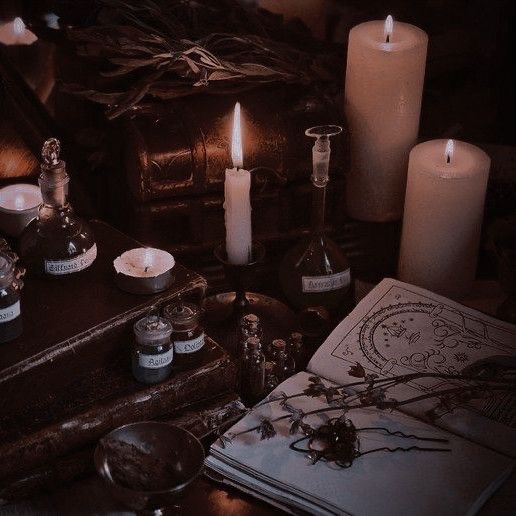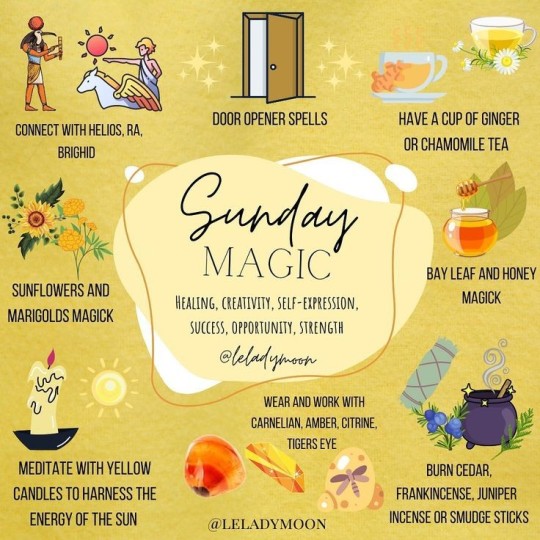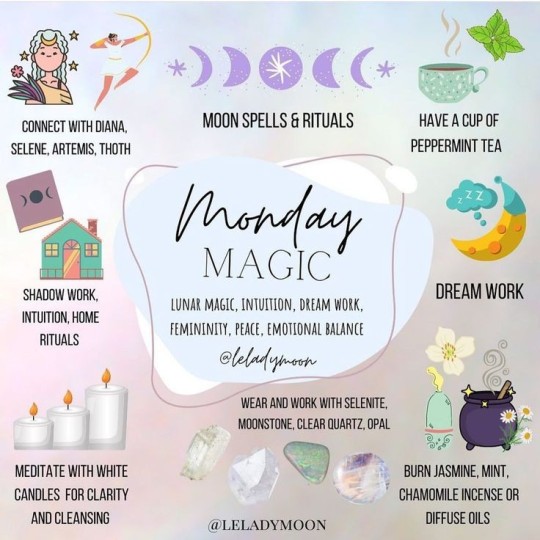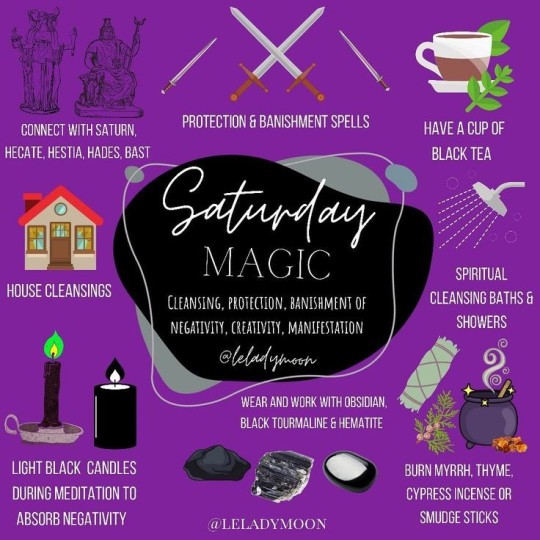Text
。゚゚・。・゚゚。
゚. October will bring blessings.
゚・。・゚
16K notes
·
View notes
Text
A Change of Heart
aka "face the consequences of your actions until you have a change of heart." Similar to A Gentle Curse, but focused more on the "karma" and change aspect.

you'll need:
a jar (any size, any kind. i used a spaghetti sauce jar)
a white candle (for cleansing the jar)
white table salt: purifying
chili powder: fast results
hot sauce: repelling the negativity from the situation
coffee: gives energy to the spell, grounds it in reality
your written intentions
a taglock of the person you wish to affect
garlic: protecting you from any negative outcomes
sun water: growth, changing outcomes, healing
cleanse the jar with the candle's smoke. add ingredients in order, while visualizing your target and intent. seal the jar, and shake it as hard as you can. whenever you have a toxic encounter with the person, shake the jar asap to recharge the spell.
if spell does not succeed, consider therapy. /lh
334 notes
·
View notes
Text
Superstitions!
The following list are some of the superstitions that I’ve heard or learned about over the years, in no particular order:
• Throw rice in the air to make it rain
• Carry a potato during winter to ward against colds
• Smell dill to get rid of hiccups
• Lay thorn branches by your doorstep to keep evil away
• Place chips of cedarwood in a box with coins do draw money to you
• Hang seaweed in the kitchen to ward off evil spirits
• Burn allspice to draw money, luck, and healing
• Place a piece of cotton in a sugar bowl to draw good luck to your home
• Scatter chili flakes around your house to break a curse
• Scatter salt/sugar to purify a room
• Put a pine branch above your bed to ward off illness
• Carry a chunk of dried pineapple to draw luck
• Ask an orange a question before you eat it, then count the seeds. Even # = no. Odd # = yes
• Toss oats outside your back door to ensure beautiful crops/plants
• Place lilacs around the house to rid unwanted spirits
• Add salt to bath for purification
• Write your sigils on stones and carry them with you
• Put sigils on medication bottles to help quicken their efficiency or for added healing benefits
• When guests come over, light a white candle by the door; it will take their negative energy and purify the home.
• To get rid of guests overstaying their welcome, turn any broom in your house upside down (bristles up)
• Toss salt on the front porch every Friday for good luck and prosperity
• Carry a blade of grass to increase psychic power
• If something or someone is bugging you, write it on toilet paper, wipe, and flush it down the toilet
5K notes
·
View notes
Photo

What is Paganism?
The term Paganism has been evolving for almost two millennia, so there is understandable confusion about what Paganism means. It has always been an umbrella term that includes within it many different faiths and practices. In this post, we are going to talk about what Paganism is (and isn’t) and explore some of the most important branches of modern Paganism (also known as Neopaganism).
Origins of the Term Paganism
The term Paganism was coined in the fourth century by Christians living in the Roman Empire for anyone who did not follow Christianity or Judaism. It comes from the Latin word paganus, which means country dweller. The implication was that these were “country bumpkins” stuck in old ways and not yet “wise” to the modern religion of Christianity. The Roman Empire officially converted to Christianity in 313 CE.
In the Middle Ages, while Islam was also viewed as a non-Pagan religion, the term Paganism continued to be used to refer to anyone who did not follow a religion based on a biblical god. It carried the derogatory connotation that Pagans worship false gods and are barbarians.
But in the 20th century, the term Paganism was reclaimed by various groups that follow religious beliefs or practices associated with pre-Christian religions. The group includes polytheists that continue to worship non-biblical pantheons, animists, magical practitioners, nature worshippers, and more.
The term Neopaganism is often used to distinguish these modern Pagans from our ancestors, who would have never referred to themselves as Pagans. Christians created the term Pagan to create “us” (biblical religions) and “them” (non-biblical religions) categories. This would not have been meaningful to our pre-Christian ancestors or to Norse warriors and Egyptian priests for whom Christianity was just one more religion.
It is worth noting that while Medieval Christians would have referred to religions such as Hinduism, Buddhism, and Taoism as Pagan, they aren’t included in the modern definition. These organized religions, which are dominant in many countries, fall into a class of their own.
Definition of Neopaganism
It is difficult to define Neopaganism because so many different people today identify with the term Paganism. It is possible to identify some characteristics that are common to most Neopagans, but don’t necessarily apply universally.
Pagan religions tend to be non-organized in that they are followed by an individual practitioner or small community rather than being a hierarchical institution like the Catholic church. But there are exceptions; for example, Hermetic orders tend to be small but very hierarchical organizations.
Pagan religions are often polytheistic, either drawing on ancient divine pantheons or following an animistic approach, which recognizes divinity in action within the world without necessarily naming it. Pagans can believe in these gods in a literal sense or as a metaphorical tool for relating to powers that are beyond our comprehension.
Pagans tend to believe that everything is sacred, especially nature, and that we can tap into the spiritual energy of the universe through meditation, invocation, rituals, witchcraft, and various other practices.
In most cases, it is an individualistic path. You choose which deities and beliefs speak to you personally, and you are responsible for creating and following your spiritual path. This very often links to a strong moral code, as you are responsible for your actions and their consequences. Pagans often identify with the idea that you can feed the universe with positive energy or diminish it with negative energy. You attract the kind of energy that you project, and what you receive mirrors what you give.
As we have already said, these characteristics do not hold true for all Pagans, but they are ideas that most Neopagans will identify with.
Branches of Neopaganism
So, if there are various branches of Neopaganism, what are they?
It is impossible to provide a complete and comprehensive list, first because we would be here forever, and second, since it is a personal and individualistic belief system, there is no limit to the number of variations that can exist.
But below, we will look at some of the most popular forms of Paganism that are most widely recognized in the Neopagan community today.
Reconstructionist Religions
Reconstructionist religions attempt to reconstruct ancient religions in the modern world. Pagans of this brand might choose to worship the Greek gods, follow the ritual practices of Egyptian priests, or walk in the footsteps of Druids.
Probably the most well-known reconstruction religion is Norse paganism, also known as Heathenry, which is the belief in the old Norse gods, including Odin, Thor, and Freyja. While exactly how this is done is individualistic, enough people identified with this type of Paganism that Asatru was created in Iceland in the 1970s to provide a common banner under which they could identify as an interest group. It is now recognized around the world.
Magic working is not a necessary part of modern Norse paganism, just as it was not in ancient times when only a few people were Volva (Seidr witches) or runemasters (workers of rune magic). But runic divination is a popular practice in modern Heathenry.
Wicca
Wicca is probably the type of Paganism most represented in pop culture (think The Craft and Charmed). It is a modern witchcraft practice, often but not always associated with the veneration of a great mother goddess and her consort, often but not always portrayed as a horned god. It can be followed by sole practitioners or coven groups led by a high priest or priestess.
Modern Wicca is credited as being founded by Gerald Gardner in the 1930s, and followers of his teachings are known as Gardnerian Wiccans. But today there are many different branches, both formal and informal.
Modern Wicca draws on what is known from historic witchcraft and magic rituals. But it is a thriving and evolving practice in which invention and following your intuition are encouraged.
Non-Wiccan Witchcraft
Not all Pagans who identify themselves as practitioners of witchcraft consider themselves Wiccan. Many follow a more shamanistic or nature-based approach to witchcraft without reference to organized elements such as covens or priests. These, usually sole practitioners, are often referred to as hedge witches.
These practitioners have a lot in common with Wiccans in their use of certain symbols and elements and closely following the cycle of the year and the phases of the moon. Grimoires and Books and Shadows are often used to record knowledge.
Hermeticism
The term Hermeticism originally referred to a religio-philosophical system based on a small number of writings known as Hermetica which gave birth to scientific approaches to magic in the form of practices such as alchemy. But Hermeticism has since become a term for those who engage in “high magic” or ritual magic, usually within a body or organization with specific teaching and hierarchies.
Probably the most famous example of these is the Hermetic Order of the Golden Dawn, an organization dedicated to the study of the occult, metaphysical, and paranormal. It is a spin-off of Freemasonry and incorporates the hierarchies and secrecy of that order. There are tests to enter new parts of the order and learn new secrets. For a number of years, the famous occultist Aleister Crowley was associated with the order.
Animism
Animism differs from other types of polytheistic paganism in that it does not necessarily feel the need to name or identify deities. Animism accepts that there is a divine or spiritual force at work in the world and it can be seen in aspects of life. But they can appreciate and be thankful for these forces without anthropomorphizing them into deities.
Animists often believe that the gods of polytheistic religions are cultural constructions designed to help humans better understand and engage with these forces. They may choose to engage with certain traditional polytheistic gods as a way of engaging with the elements of the world they consider most important.
Secular Paganism
Secular paganism could also be called a nature-based religion. Secular pagans do not necessarily believe in certain deities and could be Polytheists, Christians, Atheists, or anything in between. The core belief is that we are part of nature, rather than masters of it, and that we should live our lives with an abiding love and respect for nature.
Secular Paganism often mixes meditative and ritual practices designed to better understand and control the self with a world view based on science.
Eclectic Paganism
Eclectic Paganism is kind of a “catch-all” term for those who don’t fit into other types of Paganism. This is for people who identify with the general principles of Paganism but haven’t tied themselves to a single belief system or set or practices.
For example, they might believe in the mother goddess, but not practice witchcraft. They may feel a deep spiritual connection with the universe, witch manifests in practices such as reading Tarot cards, and cleansing spaces with incense and herbs, but may not necessarily consider these practices linked with any kind of divinity.
Eclectic Pagans often have broad interests in terms of researching different new age practices and approaches. They may also identify with Paganism aesthetically through gothic-style fashion.
Meso-Paganism
Meso-Paganism is a term used for practices that are a result of mixing non-Christian religions with Christianity imposed by conquerors, missionaries, or both. Haitian Voodoo and Candomblé in Brazil are probably the best examples, in which African deities are syncretized with Christian Saints and elements of Christian religion are incorporated into traditional rituals.
While many of the characteristics of Neopaganism apply to Meso-Paganism, followers and practitioners are less likely to identify with the broader Pagan community. These are traditional religions passed down through communities, rather than sought out by individuals. So, while they may not be the dominant religion in a certain place, they have this in common with religions such as Hinduism.
What kind of Pagan are You?
While this whole post has been dedicated to trying to define and categorize Paganism, what it really equates to is following your own spiritual path outside of the biblical context. There are no rules about what you have to believe and practices that you have to engage in. It is all about finding your own spirituality and expressing it in a way that works for you.
But we would still love to know what Paganism means to you! Let us know in the comments section below.
[Full blog post here]
869 notes
·
View notes
Text
Spell Craft Master Post

These are all of my spell-focused posts! Since spell craft is heavily personal, please understand that these are not the only way to do or craft spells. However, feel free to use these posts along side your other spell craft references!
Spell Types - Physical types of spells.
Anatomy of a Spell - What a spell needs to be a spell.
Questions for Spell Crafting - Questions to ask yourself when crafting a spell.
7-Day Spell Creation Practice - Practice for spell creation.
Spell Oils - Simple way to make spell oils.
Hex vs Curse - The difference between a hex and a curse.
Spells
Easy Spell for Sleep - My own personal spell inspired by my Nona's recipe for a sweet sleepy-time drink!
"The 9 to 5": Workplace protection spell - An old spell I created for my old job. Though it's lacking in nuance, please look to this spell for inspiration if you'd like!
Coin and Candle Success Spell - Another old spell with very basic information for you to find inspiration.
2K notes
·
View notes
Text
Samhain Cheat Sheet
It's approaching!! October 31st has many different names, some call it Halloween, Hallow's Eve, and some pagans and witches call it Samhain.
Here's a little cheat sheet I created for the coming holiday!

Check out my Samhain post to learn more about the history and modern practices you can incorporate into your own celebrations!!
Icons by: Freepik, Maxx.icon, ppangman, and koson icon on Flaticon.

686 notes
·
View notes
Text










pov: the local town witch invites you into her home
7K notes
·
View notes
Text
Witchcraft: Daily Correspondences and Practice Ideas
ー







(I love these infographs so much, I just had to post them!!)
5K notes
·
View notes
Text
What's really in that witch's cauldron?
Folk names for herbs
Ass' Ear- Comfrey
Bat's Wing- Holly Leaves
Beard Of Monk- Chicory
Bear's Foot- Lady's Mantle
Bird's Eye- Germander or Speedwell
Blind Eyes- Poppy
Blood From a Head- Lupine
Blood Of Ares- Purslane
Blood Of Hestia- Chamomile
Bloody Fingers- Foxglove
Calf's Snout- Snapdragon
Cat's Foot- Ground Ivy
Crow's Foot- Wood Anemone
Devil's Ear- Jack In The Pulpit
Devil's Plaything- Yarrow
Dew Of the Sea- Rosemary
Dog's Mouth- Snapdragon
Dragon's Teeth- Vervain
Elf Leaf- Lavender
Englishman's Foot- Common Plantain
Fairy Eggs- Nutmeg
Flower Of Death- Vinca
Goose Tongue- Lemon Balm
Graveyard Dust- Mullein
Hawk's Heart- Wormwood
Juno's Tears- Vervain
Jupiter's Beard- Sempervivums
Lion's Foot- Lady's Mantle
Little Faces- Viola
Man's Bile- Turnip Sap
Mortification Root- Rose of Sharyn
Nose Of Turtle- Turtlehead, Chelone
Nosebleed- Yarrow
Our Lady's Tears- Lily Of The Valley
Old Man's Flannel- Mullein
Ram's Head- Valerian
Scale Of Dragon- Tarragon
Semen Of Ares- White Clover
Semen Of Hermes- Dill
Serpent's Tongue- Dog's Tooth Violet
Sparrow's Tongue- Knotweed
Tree Of Doom- Elder
Unicorn Root- Boneset
Weasel Snout- Yellow Archangel
Wool Of Bat- Moss
Body Parts as Plants:
Eye- Blossom or Seed
Heart- Bud or Seed
Beak, Bill or Nose- Seed, Bud or Bloom
Tongue or Teeth- Petal or Leaf
Head- Blossom
Tail- Stem
Hair- Dried Herbs or Stringy Parts Of Herbs
Privates, Genitals Or Semen- Seeds Or Sap
Blood- Sap
Guts- Roots or Stalk
Paw, Foot, Leg, Wing or Toe- Leaves
Animals as Plants:
Toad- Sage
Cat- Catmint
Dog- Grasses, Specifically Couchgrass
Frog- Cinquefoil
Eagle- Wild Garlic
Blue Jay- Laurel
Hawk- Hawkweed
Lamb-Wild Lettuce
Nightengale- Hops
Rat- Valerian
Weasel- Rue
Woodpecker- Peony
I borrowed this from:
8K notes
·
View notes






































